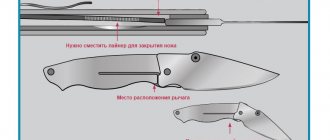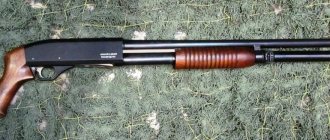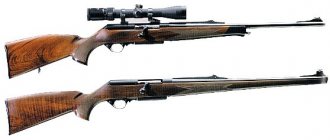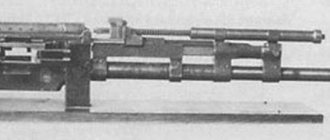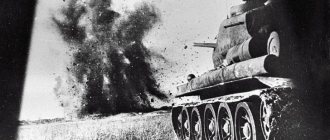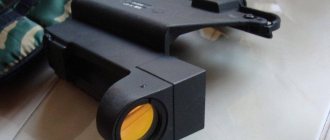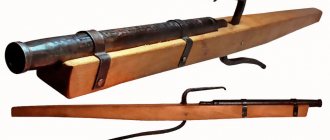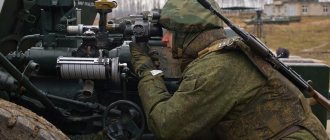The effectiveness of shooting depends on a number of characteristics. Among them, the rate of fire is of particular importance. This indicator determines how many shots a weapon can fire per unit of time.
The fastest-firing machine guns are multi-barreled. They give a slower rate of fire from one barrel. However, the overall speed is much higher than the average for single-barreled guns.
What is the rate of fire:
- Real. Combat rate of fire takes into account the need to reload weapons and aim.
- Technical. When calculating this parameter, only the total number of shots that the weapon can fire per minute matters.
- It is also worth distinguishing the rate of fire. This is the technical speed achieved when opening fire in automatic mode. Leads to overheating of the gun and increased waste of ammunition.
The maximum rate of fire is shown by multi-barrel guns made according to the Gatling scheme:
- technical - up to 10,000 rounds per minute;
- combat - up to approximately 2,000 rounds per minute.
In recent decades, it has been considered more promising to invest in the development of shooting range and accuracy. High-velocity machine guns have a very high ammo consumption, making them too expensive to use.
M 134 Minigun
M 134 is a famous American machine gun built on the Gatling principle. Shoots at speeds from 3,000 to 6,000 rpm. The problem of barrel overheating in this system is solved by air cooling. Rotation accelerates the air, which reduces the temperature of overheated elements.
Officially, the M 134 is the fastest firing machine gun in the world. This is recorded in the Guinness Book of Records.
This is a smaller version of the Vulcan aircraft machine gun. Its light weight made it possible to equip not only attack aircraft, but also other aircraft.
The supply of cartridges is linkless, or from a loose belt using the “delinker” mechanism. The rotation of the barrels is started by an electric drive. The reliability of the device and high rate of fire made this weapon the most popular machine gun.
Weapons with percussion cap lock
The first such innovation was a weapon with a more advanced ignition device - a percussion cap lock, which began to be introduced in the West in the 30s of the 19th century. The percussion cap lock had a number of advantages over the flint lock and quickly gained universal recognition. However, the Russian War Ministry, fearing large economic costs, stubbornly clung to flintlock weapons. Moreover, it not only continued to use it in the army, but even developed new models with a flintlock.
Impact capsule lock. Nearby are igniter caps.
In 1839, when many Western European armies were already rearming with the only progressive percussion-capsule weapons at that time, new types of weapons were approved in Russia, which were still equipped with archaic flintlocks. The entire improvement of the newly adopted models consisted of thickening the upper front sight, but otherwise the guns, carbines and pistols produced in 1839 were almost identical to the weapons of earlier releases.
In Russia of the 19th century, breech-loading systems with flintlocks did not develop. Among them, only the gun of Colonel John Gall, adopted exclusively by the American army in 1819 and produced for a quarter of a century by the state factory in the city of Harpers Ferry, received recognition.
A new qualitative impetus in the development of firearms was given by the invention of the initiating explosive. At that time, the most important explosive substance, mercury fulminate, was discovered by the English chemist E. Hoard in 1799. Possessing increased sensitivity to mechanical shock, it replaced seed gunpowder. The first percussion lock was invented in 1807 by Alexander Forsyth of Scotland. This invention served as the basis for the development of metal cartridges, breech-loading shotguns and other modern weapons. In A. Forsythe's castle, in place of the usual flint, there was a small rotary magazine with an explosive mixture, where after each overturning it a little fulminate of mercury fell onto the shelf, which was hit by a flint-battery type trigger with a small hammer, igniting it. The resulting jet of fire penetrated through the priming channel into the barrel and ignited the main charge of gunpowder, pushing out the bullet.
Dreyse needle rifle model 1841. A schematic section of the breech of a rifle shows the moment of impaling the flammable composition
The locks of Forsyth and his followers were quickly introduced into hunting weapons. But placing mercury fulminate in a gun lock was fraught with troubles associated with its high sensitivity to various mechanical influences and, first of all, shocks. Experiments on the use of percussion compounds were carried out in different countries independently of each other, as a result of which gunsmiths separated the initiating explosive from the lock and placed it in a metal (copper) cap - a capsule created by Egg in 1818. The military again did not immediately appreciate this invention, believing that the soldiers’ hands were too rough and incapable of manipulating small capsules.
This opinion was held longest in Russia, which was the last to appreciate the benefits of strike weapons. Not daring to leave significant reserves of flint weapons, the tsarist government compromised and decided to convert them into percussion-capsule weapons. Imitating the French in literally everything, Russian craftsmen naturally borrowed the conversion of flintlock weapons into percussion caps from France. From August 16, 1844, all available flint samples were subjected to a thorough reconstruction, and at the same time their production was stopped. Russian factories began producing samples equipped only with impact locks. However, the weapons produced were predominantly smooth-bore, because rifled guns in Russia still received clearly insufficient attention, although their fighting qualities were certainly higher. Before the Crimean War of 1853-1856, the troops had only 4% of the total number of firearms in service.
Cavalry double-rifled fitting of the 1849 model. Russia
Soldiers of nine Russian rifle battalions, equipped with rifled weapons and intended for “target shooting,” operated primer fittings of three different systems: Lüttich, Hartung and Ehrnroth. The first two had a pair of diametrically opposed rifling in the barrel and were loaded from the muzzle with a cylindrical bullet from Colonel Kulikovsky, which was inserted into the rifling with its lugs and then sent to the charge with a ramrod.
The accuracy of the firing of the fittings was uneven. Thus, the Lüttich model of 1843 had the best performance. Out of 100 bullets fired at a distance of 640 steps (426 m), at least 60 hit a target measuring 3.5 × 1.5 m.
The advantage of rifled weapons over smooth-bore weapons first appeared during the Crimean War in the battle on the Alma River in September 1854. Using long-range rifled small arms, the French and British disabled Russian infantry and artillery personnel. So, on the left flank they shot almost all the officers on horseback. In the center, the Uglitsky and Kazan infantry regiments, standing in dense battalion columns, lay down to avoid losses from destructive rifle fire. On the right flank, the British riflemen inflicted enormous damage on the artillery crews. The Russians' return fire from smooth-bore rifles was aimless: the bullets simply did not reach the enemy.
The only advantage the Russians had was in hand-to-hand combat. Russian soldiers invariably overthrew the enemy with a bayonet attack. The victory at Alma was costly for the Anglo-French forces, as they only lost 4,300 killed. After the battle, the Duke of Cambridge, who commanded one of the English divisions, sadly remarked: “Another such victory, and England will not have an army...”.
English Enfield rifle model 1853. Nearby is a triangular bayonet
The culmination of the war was the 350-day heroic defense of Sevastopol. Led by admirals Nakhimov, Kornilov, Istomin, its defenders, in need of ammunition and food, repulsed several fierce enemy assaults under continuous artillery fire. On June 18, 1855 alone, the troops of the British, French and Turks left over 7,000 people in front of the bastions of Sevastopol.
And yet, despite the courage of the Russian people, Russia was defeated in this war. The bitter experience of the Crimean War forced the Russian military leadership to turn their attention to rifled weapons during the fighting.
In 1854, a sample of an infantry rifled gun with a Belgian expansion bullet was adopted. Weak production capacity and low productivity of Russian arms factories hampered the equipping of the army with these weapons. New long-range rifles were produced in quantities barely sufficient to arm the skirmishers of infantry companies.
In contrast to the Russian army, the Anglo-French troops had powerful rifled rifles of the Thouvenin and Pritchett-Enfield systems. The English army was particularly distinguished by the superiority of its weapons, which was entirely equipped with the Enfield rifle of the 1853 model. It was fired with an expansion bullet, which, under the action of powder gases, expanded somewhat at the bottom and was pressed tightly into the rifling. Such a bullet had a flat flight trajectory and good accuracy. The devices with the help of which the distribution of the bullet, necessary for pressing it into the rifling when fired, was achieved were the chamber systems of Delvigne and Thierry and the rod system of Thouvenin.
In the French army, the most widely used rod fitting of the 1846 model of Colonel Thouvenin, with which the personnel of light infantry and partially linear infantry regiments were fully armed.
This system, following France, was adopted in the 40s of the 19th century in Belgium, Prussia, Bavaria and Saxony. The ease of loading the Thouvenin fitting was obvious: a bullet smaller than the diameter of the barrel bore easily entered it. Then pushed with a ramrod to the treasury, where the rod was screwed in, it settled on it and filled the rifling. The bullet, ejected during the shot by the force of the powder gases, had the correct rotation, which provided it with good accuracy at fairly long distances.
The problem of free delivery of a bullet when loading rifled weapons was perfectly solved with the advent of elongated self-expanding bullets. One of them were Minie bullets, which had a conical recess at the back, closed with a light iron cap. The bullet was inserted into the barrel freely, and during the shot it rang out and ran tightly along the rifling. The increase in bullet diameter occurred as a result of powder gases pressing a kind of wedge - an iron cap - into its conical recess. The idea of using such bullets was picked up in different countries. Even the Russian Tsar Nicholas I took part in the improvement of the Minie bullets. But, although his bullet turned out to be much better than the Minie bullet, it did not receive practical use, since its testing was delayed, and life put the priority in solving new problems - the creation, for example, of a treasury charging weapon.
French Thouvenin rod fitting from 1842. Nearby is a scimitar bayonet. The tip of the bayonet is moved away from the axis of the bore for ease of loading
But there were also shortcomings in the design of rifled weapons, which included the laboriousness of loading the nozzle while lying down or kneeling, and the blows of the ramrod quickly loosened the rod. In addition, the inconvenience of cleaning the space around the rod led to rapid damage to the gun. However, these shortcomings of rifled percussion-capsule systems did not affect the general trend in the development of handguns. It became obvious that the future irrevocably belongs to rifled weapons, and the Crimean War once again proved this.
Since 1853, soldiers began to learn “target” shooting, which until that moment had been practiced very little, despite the approval in 1848 of “Instructions for shooting at a target.” To improve shooting training, sports competitions began to be organized among officers, which had a positive impact on representatives of the officer corps, literally forcing them to learn to shoot accurately. The first such competition in the Russian army was held in February 1856, at which officers competed for an award - a prize weapon in shooting from a standard percussion rifle. On January 13, 1858, the “Rules for target shooting and competitions” were approved. officers in the guard troops,” according to which the winner was awarded an imperial prize, that is, a first-class personalized weapon.
All post-war activities of Russian gunsmiths were aimed at eliminating the shortcomings of small arms that emerged on the battlefields of the Crimean War. One of the reports of the Main Artillery Directorate to the War Ministry said: “Russia cannot, and should not, lag behind other major European powers in the matter of radical rearmament of its army...”. This report paid special attention to the need to arm all branches of the military with rifled weapons.
In 1856, the Russian army adopted a cassul rifle, and since then this term has firmly entered the military lexicon. The rifle had a reduced caliber (15.24 mm) and a shortened barrel, which made it lighter and more convenient. The sight of this new model allowed firing at a distance of 853 m! But, unfortunately, the rifle’s rate of fire remained the same - after all, like its predecessors, it was loaded from the muzzle. First of all, they decided to equip rifle battalions and skirmishers of rifle regiments with this rifle. Finally, after much debate, two years later rifled weapons were introduced into all infantry, and after it rifles were established in the cavalry
Henry rifle model 1860-1861, with an under-barrel magazine and a longitudinally sliding bolt controlled by a lever
In 1859-1860, shortened and lightweight models were introduced for dragoons and Cossacks, the distinctive feature of which was the absence of the usual trigger guard, which was inconvenient for equestrian formation.
Muzzle-loading capsule pistols, due to their low rate of fire, did not ensure the safety of an officer in battle, so the Russian government was forced to order more advanced multi-shot weapons abroad. It was a revolver, in the rotating drum of which several charges were placed at once.
Such weapons were invented back in the 17th century, but recognition came to them much later. Undoubtedly, much of the credit for this belongs to the American entrepreneur Samuel Colt. This clever businessman, having attributed to himself the authorship of the invention of the little-known gunsmith John Pearson, established mass production of revolvers of his design. Colt even managed to obtain a patent for this weapon. Taking advantage of machine production, he produced several models of revolvers since 1835. The first model was named “Paterson” after the city where it was released. Colt revolvers were a new rapid-fire weapon, the advantages of which over single-shot pistols were undeniable. Its distinctive feature was a rotating drum with several charges (five or six) located in its chambers.
To fire a series of shots from a revolver, the shooter only had to consistently cock the trigger and pull the trigger. In 1847, Colt revolvers were already in service in the US Army. A year later, in Hartford, Connecticut, Samuel Colt founded a weapons factory, which soon, thanks to the work of the gifted mechanic Ellis Roth, turned into a huge weapons company. Army and navy revolvers were produced here, as well as numerous types of pocket revolvers. But S. Colt did not stop there and in London founded a subsidiary of his company, which produced weapons for the British army and navy, as well as for the Canadian police. Colt sold his capsule revolvers all over the world, including in Russia, which bought a large batch of them after the Crimean War. But we still need to state the fact that Colt revolvers could not displace single-shot percussion pistols, of which the vast majority were in the army, from the weapons system.
The need to shoot quickly, especially at decisive moments of battle, has embodied various clever devices and mechanisms in small arms. Gunsmiths could not yet change the very principle of loading a weapon from the muzzle, so they decided to reduce to a minimum the time spent putting on the primer before firing. This is how the capsule clip appeared, which was a tape with capsules embedded in it. It was invented by a purely civilian man, a dentist from Washington, Edward Maynard.
An American Remington rifle of the 1857 model with a Maynard device for automatically feeding “cakes” of an impact-igniting composition, united by a thin copper strip, to the seed rod. The advancement of this tape is carried out with each cocking of the trigger (similar to how in modern children's scarecrows the advancement of a paper tape with caps is carried out)
A significant increase in the rate of fire of firearms in the 60s of the 19th century became possible only as a result of loading them from the breech. It was much easier and safer to manipulate a breech-loading gun, because it could be loaded in any position. Loading from the breech had a number of other advantages. Thanks to better penetration of the bullet into the rifling, shooting accuracy increased. The rare use of a ramrod contributed to the survivability of the gun barrel, and the convenience and ease of care ensured its long-term performance. All states began to rearm with breech-loading weapons as quickly as possible. These were rifles of talented gunsmiths: Wilson, Sharps, Dreschler, Largenu, Malherbe, Lindner and others.
Capsule breech-loading rifles: A - Maynard; B - Peri; B - Gwin and Campbell; G - Green (the lid of Maynard’s device is open. A coiled tape with igniting “cakes” and a feed ratchet are visible); D - Sharpe; E - Benjamin.
M 214 Microgun
The lightweight version of the XM 134 was designed to create high-density fire in infantry formations. With its help it was planned to arm small helicopters and cars. When mounted on a machine, it fired 4,000 bullets per minute. Potentially developed a rate of fire of up to 6,000.
However, this weapon did not become widespread. Practical application was complicated by numerous shortcomings of this development. The project remained realized only in the movies; according to the story, Arnold Schwarzenegger appears in the film “Terminator” with this weapon.
The high rate of fire made it difficult for the electrical unit to control the fire. The weight of the gun still remained significant, especially when assembled - with a machine tool, cartridges and battery. Strong recoil at a fast rate of fire reached up to 110 kg. This destroyed the fastenings, which complicated the process of managing the installation. In addition, the creators were never able to achieve good effective firing range indicators.
The design of a gun with a percussion flintlock
The design of a gun with a flintlock did not change in the 19th century. The barrel was still made of iron, and the stock of walnut or birch. The muzzle of the barrel was crowned with a long triangular bayonet. Sighting devices, as in the past, were practically absent; only a low copper front sight and a slot in the breech of the barrel served to roughly point the gun at the target. The probability of a hit when firing from flintlock rifles and pistols was relatively small: it was considered normal if 75% of the bullets fired from guns at 100 steps hit the target. The effectiveness of pistol fire was even lower, and hitting a target from a horse at a distance of 30 steps was considered a pure accident. And yet, the possibility of hitting a target with a flintlock weapon from a very short distance cannot be discounted.
6K30GSh
https://www.youtube.com/watch?v=3mRKh3mppZk
6K30GSh is an anti-aircraft gun that fires up to 5,000 rounds per minute. It is a modification of the GSh-6-30K gun made by Gryazev-Shipunov.
When created, the Gatling principle was used, based on the rotation of a block of barrels. The cooling principle is evaporative, due to accelerated air. The weapon was intended to be installed on aircraft, so the entire system is controlled remotely.
The cartridges are fed via a linkless system. To start firing, an electric charge is sent to the cartridge. The independent drive operates on powder gases. The life limit of the shots is 8,000. The weapon was installed on ships for missile defense.
Specifications
- The average magazine capacity is 20 balls. The larger it is, the longer the fighter fights without reloading.
- Product weight. You need to prepare for the fact that metal pistols are heavier. But many people like massiveness more than lightness.
- Dimensions depend on the built-in mechanism and personal preferences of the buyer. Try how the handle fits, hold the weapon, and evaluate the comfort of use while still in the store.
- The presence of elements and functions that bring the pistol closer to the original: Blowback (imitation of recoil), moving bolt frame, Hop-Up system (twisting the ball when firing for a clearer flight path).
- Possibility of installing accessories: flashlight, muffler and other additional options.
All that remains is to choose a specific sample that will suit you personally.
M61 Vulkan
developed its product in 1949, as part of a competition to create an aircraft machine gun. The design of the Vulcan was simple, but it marked a new milestone in the development of the Gatling system.
The M61A1 is the standard machine gun in service with American aircraft. In its most promising modification, it began to be used in 1956. It is distinguished by its reliable design and fires up to 6,000 – 6,000 bullets per minute.
Each barrel has its own chamber and bolt. The movement of the latter is possible due to rollers moving along a groove in the stem box. The cartridges come from the magazine using a linkless system.
Electro-capsule ignition. The drive system is usually external, hydraulic. In some modern modifications, the block is spun by an electric motor.
Completion of standard weapons review
The developers from the Rockstar Games studio made sure that there were decent weapon models in GTA San Andreas in every category. Sniper rifles are no exception, although there is little variety here.
The Country Rifle has a power of only 75 units, but the Sniper Rifle has 125. The weapon with a firing range of up to 40 meters is great for kills from the observation deck on the roof of a building in the city center. Every user should definitely try them. There are also heavy weapons in GTA San Andreas.
Sniper rifle Sniper Rifle
For example, a flamethrower is suitable for crowds of people at close range. It even affects some buildings, as well as vegetation. Rocket Launcher and Heat-Seeking RPGs are best suited for causing complete mayhem. The second weapon also differs in its shells, which are aimed at the target using a thermal signature. They deal shot, burn and explosion damage, but even then they are no match for the Vulcan.
This is a machine gun with a clip of 500 rounds and damage of 140 units. It is capable of mowing down crowds of enemies in front of the protagonist’s eyes. Don’t also forget about the presence of mines with remote detonation, Molotov cocktails, and grenades. CJ is an extraordinary person, and therefore can even use phallic symbols or a beautiful bouquet of flowers as weapons.
GSh-6-23
The Gryazev-Shipunov GSh-6-23 design used the Gatling system. This is a 6-barrel aircraft machine gun that fires 9,000 bullets per minute. Rotating barrels with bolts are combined into one block. It rotates in a fixed casing, along with the central star.
The shutters slide along the star, simultaneously making reciprocating movements. For each revolution they are recharged. The barrels at the same time fire a series of successive shots.
Acceleration is provided by a cassette pyrostarter with 10 squibs. The automation operates on the gun’s own powder gases. They enter the engine from the barrels through special holes.
Due to the high feed speed of the cartridges, the belt jerks and the links burst. Strong recoil loosens the mounts, knocks down the sight and has a bad effect on aircraft equipment. It is more effective to fire in short bursts. Reliability life – 18,000 shots.
Automatic rifle FA MAS F1 (Manufactory Darme, France)
The first mass-produced bullpup assault rifle, produced since 1973 and popular in many countries around the world. Because of its shape, it is also known by the slang name “kleron” (“horn”). The FA MAS automatic system works due to the release of a semi-free lever shutter. The chamber is equipped with special 16 longitudinal Ravelli grooves, each 44 mm long. They provide a phenomenal rate of fire (1000 rounds per minute!) with instant removal of cartridges and high retention of shooting accuracy. The machine gun is also equipped with mounts for a bayonet and an under-barrel grenade launcher. FA MAS is a reliable and durable weapon, time-tested. Until recently, this was the main machine gun of the French army. In 2016, it was decided to gradually switch to the German NK416. Reasons: incompatibility with basic NATO assault rifles; the need to produce non-standard steel casings for the FA MAS, because standard brass casings are deformed during shooting and jam; during long bursts, the barrel inevitably “leads” away from the aiming line. But FA MAS continue to be produced for police special forces and for export to other countries.
MetalStorm
Australian and American specialists jointly developed a machine gun with a colossal rate of fire. A million or more rounds per minute are fired by the Metal Storm machine gun, created according to the O'Dwyer principle. This is the highest rate of fire for machine guns. At the same time, 1 barrel shoots about 45,000 rounds/min.
The traditional system of mechanical strikers cannot provide this. It was replaced by starters, which ignite charges due to electrical impulses. Several rounds are supplied at a time - from 3 to 6 at a time. The intervals between shots were reduced to a fraction of a second. All moving parts from the structure were removed, the only exception being the trigger. The creator also experimented with the number of rifled barrels.
| Place | Name | Caliber | Rounds/min | A country |
| 1 | Metal Storm | 9 | 1 million - 1.62 million | Austria |
| 2 | TRW HIVAP | 7,87 | 30 000 — 60 000 | USA |
| 3 | GSh -6-23 | 23 | 9000 | USSR |
| 4 | M61 Vulkan | 20 | 6000 — 6600 | USA |
| 5 | 6K30SH | 30 | 4500 — 5000 | RF |
| 6 | M214 Microgun | 5,56 | 4000 — 6000 | USA |
| 7 | M134 Minigun | 7.62 | 3000 — 6000 | USA |
| 8 | Twin bullet MSSh | 7,62 | 6000 — 6400 | USSR |
| 9 | JakB | 12,7 | 4000 — 4500 | USSR |
| 10 | GAU-8 | 30 | 3900 — 4200 | USA |
Related Posts
The fastest-firing machine guns The fastest-firing pistols
Top 10 Best Slot Machines in the World
Armament factories and production of small arms in Russia
At the beginning of the 19th century, the production of small arms was concentrated at the Tula, Sestroretsk and Izhevsk arms factories. The largest of them was Tula, whose design capacity at that time was 100,000 guns per year. But due to a lack of production capacity and outdated equipment, the plant until 1806 produced no more than 45,000 guns annually.
The impending war with France forced the War Ministry in 1810 to sharply increase the small arms production program, but due to the bureaucratic red tape of tsarist officials, it turned out to be unsustainable. And instead of the planned 146,000 guns, only 99,000 were transferred to the troops and arsenals. Tula alone produced 10,000 new guns every month and repaired 3,000 damaged guns. 19 private Tula manufactories were involved in the production of military weapons, which produced up to 3,000 guns every month. The workers of Sestroretsk and Izhevsk worked hard, sending 18,614 rifles and 1,200 pairs of pistols to the army to defeat the enemy.
Russian gunsmiths, guided by the experience of the Napoleonic wars, made some changes to the samples of army flint weapons, which affected, first of all, the barrel, stock and sighting devices. Thus, the new Russian infantry rifles, prepared by the inspector of arms factories, General Staden, and the Polish service general, Bontan, in 1826 and 1828, had barrels 9 cm shorter than the previous models. In addition, it has become more convenient to aim from the new guns, since a semblance of a rear sight and withers with a slot appeared on the breech, and the front sight was moved from the stock ring to the barrel. These innovations indicated the beginning of the process of improving sighting devices. By increasing the bevel of the butt in the new weapon, it was possible to weaken the effect of recoil on the shoulder of the shooter, and the soldiers, who could hardly bear the recoil of old guns, were most pleased with the latest innovation. The overall length of the guns of the 1826 and 1828 models, due to the lengthening of the bayonet, remained the same.
Russian 6-line rifle model 1856. Nearby is a triangular bayonet
In the same year, 1828, four new models were approved for various branches of cavalry: dragoon, cuirassier, hussar and horse-jaeger rifles. All of them had a smooth barrel and were loaded from the muzzle. Five years later, the cavalrymen received another model - a carbine of the 1833 model.
In the middle of the 19th century, guns with flintlocks became obsolete, and only when advances in the field of chemistry and the general development of technology made it possible to put into practice some fundamental innovations did the broadest opportunities open up for the further development of small arms.
Ebony Blade
The Ebony Blade is a Daedric two-handed sword, created by Princess Mephala. Other weapon names: "Leech" and "Vampire". The sword is made in the form of a katana, and its enchantment makes it possible to deliver up to 45 blows without recharging. The ebony blade will be especially useful during battles with magicians, as it imposes the “Silence” effect on them.
The sword is a reward for completing Princess Mephala's quest "The Door That Whispers". To take this quest, you will need to be level 20 and complete the Dragon in the Sky quest. “The Door That Whispers” is the simplest task with a good reward for level 20.
The most effective.
The Russian army has a heavy flamethrower system TOS-1 with the funny name “Buratino”. But it won’t be funny for those Karabas-Barabas who will find themselves under his volley. 30 missiles fired in 7.5 seconds burn out EVERYTHING in an area of 1 square kilometer. “Everything” means EVERYTHING from a bacterium to a tank. (It is argued that this installation can be used to burn out areas contaminated with bacteriological weapons). The warhead takes up most of the rocket projectile. Therefore, its flight range is not large - only 3 km. TOS-1 is literally a piece weapon. It is too crude for anti-terrorist operations. And in full-scale combat operations, it loses to the Smerch multiple rocket launcher, which can send 12 missiles with volumetric explosion charges over a distance of 90 km. But the TOS-1 salvo itself resembles a small nuclear explosion and is very effective. "Pinocchio" burns!
What is the best machine gun in the world?
The National Interest publication has published a ranking of the world's best portable machine guns. The leader was the Kalashnikov machine gun. The experts explained their choice by the fact that the Kalashnikov machine gun is light (about 7.5 kilograms), but reliable and durable. That is why it can be called one of the most dangerous weapons in the world.
Interesting materials:
Which cellular organelle contains its own circular DNA? What is the climate in the Oryol region? What code opens all intercoms? What indoor flower should I give a woman for her birthday? What ship is the Titanic? What is the best paint to paint a guitar? What paint can be used to paint MDF furniture? What paint can you use to paint dried flowers? What crop is potato? What is the limit for comments on VKontakte?
